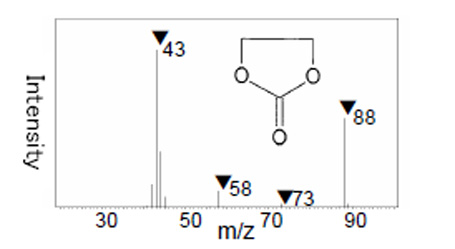Disassembly Investigation of Batteries and Capacitors, Investigation for Deterioration and Defect,
and Structural Analysis
Analysis of Liquid and Solid Electrolytes
The liquid electrolyte in a lithium (Li)-ion battery consists of multiple solvents, electrolyte, minute additives, etc., and its components may be modified or a byproduct may be generated depending on the battery's action. Therefore, it is a very important element in analyzing the cause of deterioration of the battery.
JFE-TEC can also contribute to deterioration investigation and defect analysis through analysis of an infinitesimal amount of a modified component in a liquid electrolyte based on chromatography methods (GC-MS, LC-MS), measurement of a lithium (Li) diffusion coefficient based on the pulsed field gradient nuclear magnetic resonance (PGSE-NMR) method, quantification of the electrolyte components based on multinuclear NMR (1H, 13C, 11B, 19F, 31P), quantification of metallic ions based on inductively-coupled plasma (ICP) method, and quantification a minute moisture content using a Karl Fischer moisture meter, and so on.
Analysis of Liquid Electrolyte
Quantitative Analysis of the Composition and Components in Liquid Electrolyte (Analysis Based on Chromatography)
In analyzing the composition and the determinate quantity of each component in liquid electrolyte, we conduct a quantitative analysis using various chromatography methods.
- Gas chromatography mass spectrometry (GC-MS)
- Liquid chromatography mass spectrometry (LC-MS) For quantifying the composition and components in a liquid electrolyte
Example of analysis through gas chromatography mass spectrometry
We collected liquid electrolytes from a new commercial battery and a commercial battery that had been used for a long time, and investigated the relative ratios of major components and modified products in the long-used battery through GC-MS analysis.


| Relative ratio (%) | ||
|---|---|---|
| New cell | Long-used cell | |
| Ethyl-methyl carbonate (EMC) | 37.7 | 30.8 |
| Diethyl carbonate (DEC) | 25.6 | 38.5 |
| Ethyl carbonate (EC) | 12.7 | 6.8 |
| Overcharge protection agent | 24.0 | 22.8 |
| Modified product | - | 1.1 |
Compared with the new cell, the long-used cell showed smaller amounts of EMC and EC contents.
The presence of a substance inferred to be a modified product of a detected major component was confirmed.
Measurement of the Li Diffusion Coefficient in a Liquid Electrolyte (Measurement Based on NMR [Nuclear Magnetic Resonance])
- Pulsed field gradient NMR (PGSE-NMR):
NThe diffusion coefficient of ions including the target nuclide can be measured by inserting a magnetic field gradient pulse during the NMR measurement. - Multinuclear NMR:
It covers various nuclides such as 11B, 19F and 31P, in addition to 1H and 13C.
Qualitative and Quantitative Analysis of Metallic Components (Analysis Based on Inductively-Coupled Plasma Method [ICP Method])
Qualitative and quantitative analysis of metallic components is conducted by using inductively-coupled plasma method (ICP method).
-
ICP mass spectrometry (ICP-MS)
Highly sensitive ICP-MS is suitable for the detection of minute metallic ions dissolved in the liquid electrolyte. - ICP emission spectroscopy (ICP-AES)


